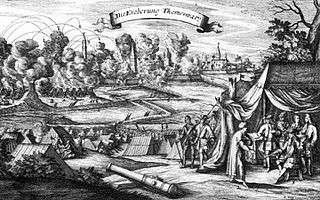
The Treaty of Passarowitz, or Treaty of Požarevac, was the peace treaty signed in Požarevac, a town that was in the Ottoman Empire but is now in Serbia, on 21 July 1718 between the Ottoman Empire and Austria of the Habsburg monarchy and the Republic of Venice.

Caransebeș is a city in Caraș-Severin County, part of the Banat region in southwestern Romania. One village, Jupa, is administered by the city.

Banat is a geographical and historical region that straddles Central and Eastern Europe. It is currently divided among three countries: the eastern part lies in western Romania ; the western part of Banat is in northeastern Serbia ; and a small northern part lies within southeastern Hungary.

The Banat Military Frontier or simply Banat Frontier was a district of the Habsburg monarchy's Military Frontier during the 18th and 19th centuries. It was located in southern parts of the Banat region. It was formed in 1764, out of territories of the Banat of Temeswar. Today, the territory is split between Serbia and Romania.

The Military Frontier was a borderland of the Habsburg monarchy and later the Austrian and Austro-Hungarian Empire. It acted as the cordon sanitaire against incursions from the Ottoman Empire.

The North Banat District is one of seven administrative districts of the autonomous province of Vojvodina, Serbia. It lies in the geographical regions of Banat and Bačka. According to the 2022 census, the district has a population of 117,896 inhabitants. The administrative center of the district is the city of Kikinda.

County of Temes was an administrative county (comitatus) of the Kingdom of Hungary. Its territory is now in southwestern Romania and northeastern Serbia. The capital of the county was Temesvár, which also served as the kingdom's capital between 1315–1323.

Torontál was an administrative county (comitatus) of the Kingdom of Hungary. Its territory is now divided between Serbia and Romania, except for a small area which is part of Hungary. The capital of the county was Nagybecskerek, the current Zrenjanin.
This article is about the History of Timișoara, the largest and most important city in the Romanian Banat. Timișoara is also known by the following names: Hungarian: Temesvár, German: Temeswar / Temeschwar / Temeschburg, Serbo-Croatian: Temišvar / Темишвар, Turkish: Tamışvar / Temeşvar.

The Austro-Turkish War (1716–1718) was fought between Habsburg monarchy and the Ottoman Empire. The 1699 Treaty of Karlowitz was not an acceptable permanent agreement for the Ottoman Empire. Twelve years after Karlowitz, it began the long-term prospect of taking revenge for its defeat at the Battle of Vienna in 1683. First, the army of Turkish Grand Vizier Baltacı Mehmet defeated Peter the Great's Russian Army in the Russo-Turkish War (1710–1711). Then, during the Ottoman–Venetian War (1714–1718), Ottoman Grand Vizier Damat Ali reconquered the Morea from the Venetians. As the guarantor of the Treaty of Karlowitz, the Austrians threatened the Ottoman Empire, which caused it to declare war in April 1716.

The Province of Temeşvar, known as Province of Yanova after 1658, was a first-level administrative unit (eyalet) of the Ottoman Empire located in the Banat region of Central Europe.

Kovin is a town and municipality located in the South Banat District of the autonomous province of Vojvodina, Serbia. The town has a population of 13,515, while the municipality has 33,722 inhabitants.
Vojvodina is an autonomous province located in northern Serbia. It consists of the Pannonian Plain in the south, and the Danube and Sava rivers in the north.

Jaša Tomić is a town located in the municipality of Sečanj, in the Central Banat District of Serbia. It is situated in the Autonomous Province of Vojvodina. The town has a Serb ethnic majority and a population numbering 2,982 people.

Srpski Krstur is a village located in Serbia, in the Novi Kneževac municipality of the North Banat District, in the Autonomous Province of Vojvodina. The village has a Serb ethnic majority (69.81%) with a present Romani (13.58%) and Hungarian minority (9.38%). It has a population of 1,620 people.

The Eparchy of Banat is an ecclesiastical territory or eparchy of the Serbian Orthodox Church in the Banat region, Serbia. It is mostly situated in the autonomous province of Vojvodina, while the eparchy also includes a small south-western part of Banat that belongs to the City of Belgrade as well as village of Ostrovo that belongs to the city of Požarevac. The seat of the eparchy is in Vršac.

Pomorišje is a historical geographical region on the banks of the river Mureș that in the past has had a sizable ethnic Serb population. The region is mostly divided between Romania and Hungary, with small part of it in northern Serbia. Today, a Serb minority is present in parts of the region that are part of Romania and Hungary.
Banat is a geographical and historical region of southeastern Europe.

The Kingdom of Serbia was a province (crownland) of the Habsburg monarchy from 1718 to 1739. It was formed from the territories to the south of the rivers Sava and Danube, corresponding to the Sanjak of Smederevo, conquered by the Habsburgs from the Ottoman Empire in 1717. It was abolished and returned to the Ottoman Empire in 1739.

The siege of Temeşvar took place from 31 August to 12 October 1716 during the Austro-Turkish War of 1716-1718. The Habsburg army led by Prince Eugene of Savoy, who had just won a crushing victory at Petrovaradin, managed to capture the fortress of Temeşvar an Ottoman stronghold since 1552, the capital of the Banat and the last Turkish stronghold in Hungary. The garrison capitulated after a 43 days siege. The city remained under military administration until 6 June 1778, when it was handed over to the administration of the Kingdom of Hungary.






















